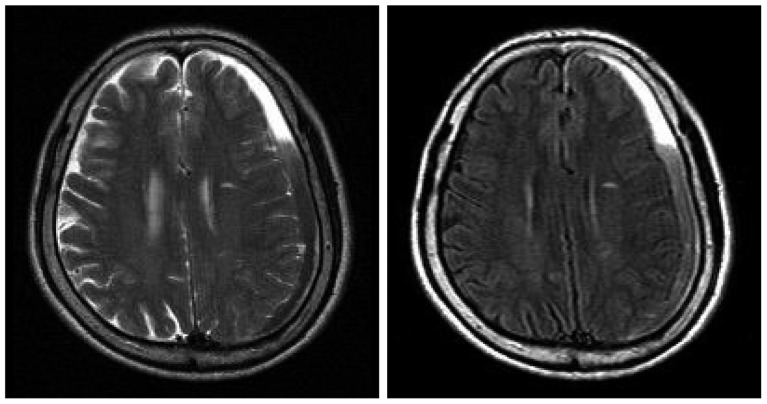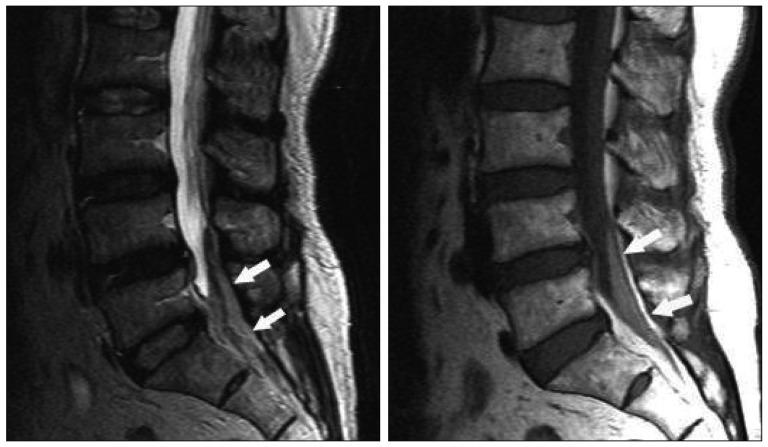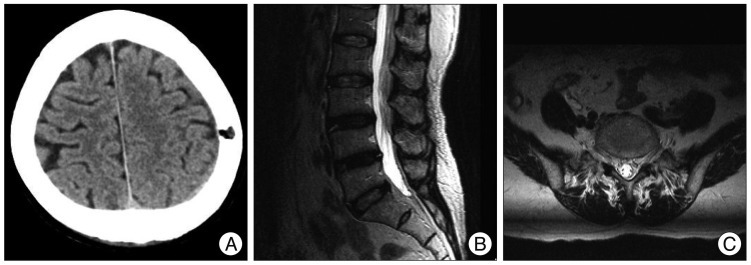J Korean Neurosurg Soc.
2012 Apr;51(4):237-239. 10.3340/jkns.2012.51.4.237.
Spontaneous Concomitant Intracranial and Spinal Subdural Hematomas in Association with Anticoagulation Therapy
- Affiliations
-
- 1Department of Neurosurgery, School of Medicine, Chosun University, Gwangju, Korea. ns64902@hanmail.net
- 2Department of Rehabilitation, Wonju College of Medicine, Yonsei University, Wonju Christian Hospital, Wonju, Korea.
- KMID: 2066919
- DOI: http://doi.org/10.3340/jkns.2012.51.4.237
Abstract
- Simultaneous intracranial and spinal subdural hematomas are extremely rare. In most cases, they are attributed to major or minor trauma and iatrogenic causes, such as those resulting from spinal puncture. To the best of the authors' knowledge, there has been only two reports of spontaneous concomitant intracranial and spinal subdural hematomas in a patient receiving anticoagulant therapy who had an absence of evident trauma history. We report on a case of spontaneous concomitant intracranial and spinal subdural hematomas that occurred in association with anticoagulant therapy and present a review of the relevant literature.
Keyword
Figure
Cited by 1 articles
-
Spontaneous Spinal Subdural Hematoma with Simultaneous Cranial Subarachnoid Hemorrhage
Hwan-Su Jung, Ikchan Jeon, Sang Woo Kim
J Korean Neurosurg Soc. 2015;57(5):371-375. doi: 10.3340/jkns.2015.57.5.371.
Reference
-
1. Bortolotti C, Wang H, Fraser K, Lanzino G. Subacute spinal subdural hematoma after spontaneous resolution of cranial subdural hematoma : causal relationship or coincidence? Case report. J Neurosurg. 2004; 100:372–374. PMID: 15070147.
Article2. Hung KS, Lui CC, Wang CH, Wang CJ, Howng SL. Traumatic spinal subdural hematoma with spontaneous resolution. Spine (Phila Pa 1976). 2002; 27:E534–E538. PMID: 12486364.
Article3. Jain V, Singh J, Sharma R. Spontaneous concomitant cranial and spinal subdural haematomas with spontaneous resolution. Singapore Med J. 2008; 49:e53–e58. PMID: 18301828.4. Jimbo H, Asamoto S, Mitsuyama T, Hatayama K, Iwasaki Y, Fukui Y. Spinal chronic subdural hematoma in association with anticoagulant therapy : a case report and literature review. Spine (Phila Pa 1976). 2006; 31:E184–E187. PMID: 16540860.5. Kim HY, Ju CI, Kim SW. Acute cervical spinal subdural hematoma not related to head injury. J Korean Neurosurg Soc. 2010; 47:467–469. PMID: 20617096.
Article6. Leber KA, Pendl G, Kogler S, Kammerhuber F, Ebner F. Simultaneous spinal and intracranial chronic subdural hematoma. Case illustration. J Neurosurg. 1997; 87:644. PMID: 9322857.7. Lecouvet FE, Annet L, Duprez TP, Cosnard G, Scordidis V, Malghem J. Uncommon magnetic resonance imaging observation of lumbar subdural hematoma with cranial origin. J Comput Assist Tomogr. 2003; 27:530–533. PMID: 12886137.
Article8. Nicholas DS, Weller RO. The fine anatomy of the human spinal meninges. A light and scanning electron microscopy study. J Neurosurg. 1988; 69:276–282. PMID: 3392571.9. Ohta H, Ottomo M, Nakamura T. [A case of the spinal subdural hematoma formation following ventriculoperitoneal shunting for von Recklinghausen's disease associated with aqueductal stenosis]. No Shinkei Geka. 2001; 29:53–57. PMID: 11218767.10. Shimizu S, Tachibana S, Maezawa H, Fujii K, Kan S. Lumbar spinal subdural hematoma following craniotomy--case report. Neurol Med Chir (Tokyo). 1999; 39:299–301. PMID: 10358985.11. Silver JM, Wilkins RH. Spinal subdural hematoma formation following ventriculoperitoneal shunting for hydrocephalus. Case report. Acta Neurochir (Wien). 1991; 108:159–162. PMID: 2031476.
Article12. Tillich M, Kammerhuber F, Reittner P, Leber KA, Szolar DH. Chronic spinal subdural haematoma associated with intracranial subdural haematoma : CT and MRI. Neuroradiology. 1999; 41:137–139. PMID: 10090608.
Article13. Wurm G, Pogady P, Lungenschmid K, Fischer J. Subdural hemorrhage of the cauda equina. A rare complication of cerebrospinal fluid shunt. Case report. Neurosurg Rev. 1996; 19:113–117. PMID: 8837111.
Article14. Yamaguchi S, Hida K, Akino M, Yano S, Iwasaki Y. Spinal subdural hematoma : a sequela of a ruptured intracranial aneurysm? Surg Neurol. 2003; 59:408–412. discussion 412. PMID: 12765819.15. Yamaguchi S, Kurisu K, Arita K, Takeda M, Tani I, Araki O. Simultaneous cranial and spinal subdural hematoma. Neurol Med Chir (Tokyo). 2005; 45:645–649. PMID: 16377954.
- Full Text Links
- Actions
-
Cited
- CITED
-
- Close
- Share
- Similar articles
-
- Spontaneous Spinal Subdural and Subarachnoid Hemorrhage with Concomitant Intracerebral Hemorrhage: A Case Report
- Traumatic Spinal Subdural Hematoma Accompanying intracranial hematoma: Spontaneous Resolution after Pumbar Puncture
- Spinal Subdural Hematoma Following Cranial Subdural Hematoma : A Case Report with a Literature Review
- Whole Lumbar Spinal Subdural Hematoma with Progressive Paraplegia after Lumbar Spinal Epidural Injection
- Spontaneous Spinal Subdural Hematoma with Simultaneous Cranial Subarachnoid Hemorrhage




